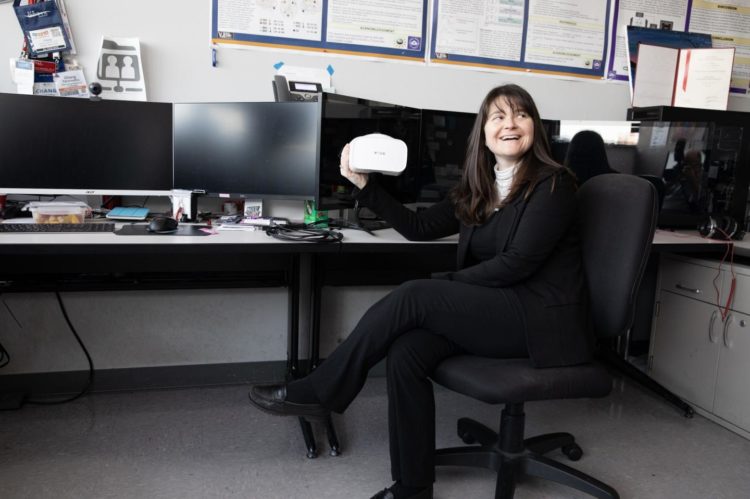
Credit: NJIT
Tara Alvarez, a professor of biomedical engineering at New Jersey Institute of Technology (NJIT) who studies the links between visual disorders and the brain and develops novel devices to identify and treat them, has been named a fellow of the American Academy of Optometry (AAO).
Alvarez joined approximately 300 fellows, who are the leading scientists and clinicians in the field, at an induction ceremony this month at the academy’s 2019 annual meeting in Orlando, Fla. At the conference, she gave a talk on the neural mechanisms underlying a vision therapy that helps patients with a disorder known as convergence insufficiency (CI) to read and focus clearly on close objects. That research was recognized by the academy as among the “10 most newsworthy of 2019.”
“It’s difficult to become a fellow as a researcher – the vast majority of inductees are clinicians, so I’m thrilled that my team’s work was recognized for its significant impact on clinical practice. What’s most exciting, however, is that it will open up even more opportunities for my lab to do clinical work,” Alvarez noted.
She added, “I was surprised – and delighted – that the Academy chose to issue a press release about our research at the conference. Because it was held in conjunction with the Third World Conference of Optometry, it was an international event that drew thousands of pioneers in the field from all over the world.”
Her research, funded by the National Eye Institute and conducted in collaboration with Mitchell Scheiman, O.D., Ph.D. at Salus University, Philadelphia College of Optometry, began with a study on mechanisms that may cause CI, in which the muscles that control eye movements do not coordinate to focus on near objects. Because each eye sees images separately, the person experiences double and blurred vision, headaches and difficulty concentrating. Patients routinely complain of reading slowly or having to reread text. The impact on cognition and learning can be severe, particularly in children.
Together, they examined symptoms that severely affect a person’s ability to make transitions between near and far spaces. They studied clinical symptoms, eye movements and functional imaging to understand how conventional office-based therapy leads to a sustained reduction in these symptoms that is sustained for at least a year.
CI is also one of the primary symptoms of concussion, in which about half of the civilian and military populations with post-concussive syndrome experience it for varying lengths of time. Alvarez is working with major children’s hospitals around the country to test her devices. Her goal is to one day put them in the hands of coaches and trainers on the field, for example, to help them determine if it’s safe to return a shaken-up player to the game. Follow-on blows can be devastating in the near- and long-term.
As she explained, “The visual neural circuit composes a lot of space in the brain, and is thus easily damaged by a concussion. In terms of cognitive load, if someone is expending significantly more energy acquiring visual information, then less energy is available for thinking.”
Her diagnostic machine uses data from a functional near-infrared spectroscopy (fNIRS) imaging machine, as well as from functional imaging. Strapped to the head, the fNIRS machine uses light beams to measure blood oxygen levels – indicators of neural activity – in different regions of the brain. An ocular device Alvarez has created, known as a vision and neural assessment equipment system, measures eye movements and accommodation – the ability to see images clearly, which are promising biomarkers for neurological functions such as visual attention and memory. Long term, her team’s diagnostic and therapeutic platform will leverage commercially available virtual reality (VR) equipment and a video-based eye-tracking system with proprietary software to detect how changes in eye movement behavior following an injury, including a mild concussion, correspond to brain activity.
With a team of engineers, computer scientists, artists and clinicians, including Scheiman, Alvarez is using their research to develop new instruments to diagnose and treat CI, specifically with VR vision therapy games running on commercially available VR head-mounted displays. While office-based therapy is effective in about 75 % of patients with CI, home-based therapies are no more effective than a placebo. Her team aims to change that.
“We’re working on therapeutic interventions to boost treatment success rates, reduce the time to remediation and shave health care costs,” Alvarez noted, adding “Our strategy is to ‘sugar coat’ therapy by having patients perform what has been until now a somewhat dull exercise, in a fun, interactive VR game. Ultimately, we want patients, and especially kids, to not even realize they are doing therapy.”
Her team, including John Vito d’Antonio-Bertagnolli ’16 Honors College MS ’17 and Chang Yaramothu ’13 MS ’14 Ph.D. ’17, won two major international awards for its vision therapy platform known as VERVE (Virtual Eye Rotation Vision Exercises), including “most innovative breakthrough,” at the joint 2018 Augmented World Expo Europe and IEEE VR First, the leading industry conference for augmented reality technology.
Later that year, Alvarez was named a fellow of the American Institute for Medical and Biological Engineering, the top 2% of biomedical engineers.
###
About New Jersey Institute of Technology:
One of only 32 polytechnic universities in the United States, New Jersey Institute of Technology (NJIT) prepares students to become leaders in the technology-dependent economy of the 21st century. NJIT’s multidisciplinary curriculum and computing-intensive approach to education provide technological proficiency, business acumen and leadership skills. NJIT is rated an “R1” research university by the Carnegie Classification®, which indicates the highest level of research activity. NJIT conducts approximately $170 million in research activity each year and has a $2.8 billion annual economic impact on the State of New Jersey. NJIT is ranked #1 nationally by Forbes for the upward economic mobility of its lowest-income students and is ranked 53rd out of more than 4,000 colleges and universities for the mid-career earnings of graduates, according to PayScale.com. NJIT also is ranked by U.S. News & World Report as one of the top 100 national universities.
Media Contact
Tanya Klein
[email protected]
973-760-6058
Original Source
https:/





